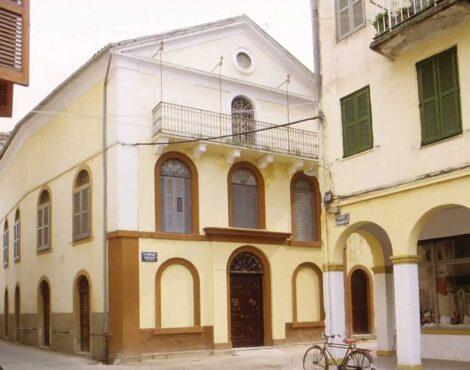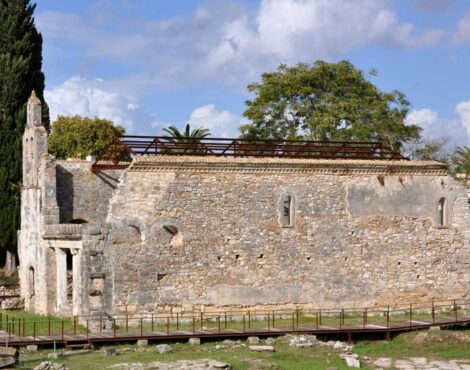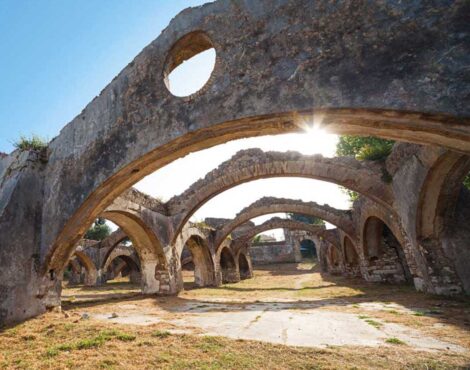Garitsa and Kanoni
Garitsa is a historic suburb of Corfu Town, renowned for its coastal character and rich cultural heritage. Located southeast of the city center, it stretches along Garitsa Bay, offering breathtaking views of the Ionian Sea and the Old Fortress of Corfu, a landmark that symbolizes the island.
The area is traversed by three main roads: the coastal avenue Leoforos Dimokratias and the streets Mitropolitou Athanasiou and Alkiviadou Dari. Running parallel to the coastal avenue is the Garitsa Grove, a picturesque park approximately 1,065 meters in length. It begins at the Douglas Column and extends to the Windmill (Anemomylos). This green space is ideal for walks, providing shade under the dense laurel trees, palm trees, and ancient eucalyptus, particularly in the Anemomylos area. The grove is one of the most significant green spaces within the urban fabric of Corfu and owes its existence to the British, who ruled the island until 1864, when Corfu was integrated into Greece. Historically, Garitsa was a working-class neighborhood in Corfu. During the 19th century, it was home to various factories, including rope-making and flour mills, which employed a large portion of the population. The daily lives of residents were synchronized with the factory sirens, which marked shift changes and functioned as an unofficial clock for the community.
Even after the closure of these factories, Garitsa maintained its traditional character. Its narrow alleys, known as kantounia, feature low-rise houses with small tiled roofs, many of which were built by refugees after 1922. Walking through these streets feels like stepping into an old Greek movie set, where residents sit on their doorsteps, chatting and observing the rhythm of daily life. Garitsa’s seaside area is particularly popular for strolls, with the grove providing cool shade and spectacular sea views. Along the coast, one can find fishermen casting their lines, street vendors roasting corn, and people of all ages enjoying the view of the Old Fortress. Numerous restaurants and traditional taverns line the waterfront, offering both locals and visitors flavors inspired by the island’s gastronomy. The cuisine of Corfu is famous for its Venetian influences, with dishes such as pastitsada (braised meat with pasta), sofrito (beef in a white wine and garlic sauce), and bourdeto (spicy fish stew) being local favorites.
Today, Garitsa blends its historical heritage with modern activities. The grove is a hub for various recreational activities, including cycling, basketball games, and pétanque (a French game similar to bocce), a legacy of the British presence. The area fosters a vibrant community where public spaces play a central role in the social life of its residents. Garitsa is a unique blend of history, culture, and natural beauty, offering visitors and residents an authentic Corfiot experience. It is close to the town yet feels removed from the fast-paced modern world, making it a serene escape.
Just a few meters separate Garitsa from another iconic area of Corfu—Kanoni. This region is famous for its stunning natural beauty and rich historical significance. Located about 4 kilometers south of Corfu Town, Kanoni is situated on a peninsula that provides panoramic views of the Chalikiopoulos Lagoon, the famous Mouse Island (Pontikonisi), and the Monastery of Panagia Vlacherna. The name Kanoni (meaning “Cannon”) dates back to the French occupation, when in 1798, the French Republicans installed an artillery battery in the area. One of the cannons from that era is still preserved today, serving as a historical monument and a point of reference for visitors. Kanoni is closely linked to Corfu’s ancient history. The area of Paleopolis, near Kanoni, is where the ancient city of Corfu was founded in the 8th century BC. Archaeological excavations have uncovered significant ruins, including the Temple of Artemis, which highlight the island’s rich historical legacy. One of the most defining features of Kanoni is its breathtaking views. From the main viewpoint of the area, visitors can admire the sight of the Monastery of Panagia Vlacherna, connected to the mainland by a narrow causeway. Beyond it lies Mouse Island (Pontikonisi), a lush islet with the picturesque chapel of Pantokrator. According to local legend, Pontikonisi is believed to be the petrified ship of Odysseus, transformed into stone by Poseidon in Homer’s Odyssey. Whether this myth holds true or not, the island’s striking presence in the middle of the blue Ionian waters makes it a must-visit spot.
The Chalikiopoulos Lagoon, stretching beneath Kanoni, is an important wetland habitat for many bird species, offering unique opportunities for nature observation. A pedestrian bridge connects Kanoni with the opposite area of Perama, allowing visitors to experience a scenic walk over the lagoon. One of the most fascinating aspects of this bridge is that it offers a prime spot to watch airplanes land and take off from Corfu’s airport, as the flight path runs directly overhead. The close-up view of aircraft passing just above creates a thrilling and unforgettable experience for aviation enthusiasts and casual visitors alike. Kanoni is home to luxury hotels, charming cafes, and restaurants where visitors can enjoy local delicacies against a backdrop of spectacular scenery. The area is easily accessible from Corfu Town, making it an ideal destination for day trips or even longer stays.
More than just a place of natural beauty, Kanoni is a location where history, culture, and nature harmoniously coexist. It is one of the most beloved destinations in Corfu, offering visitors a chance to explore the past while soaking in the present.





